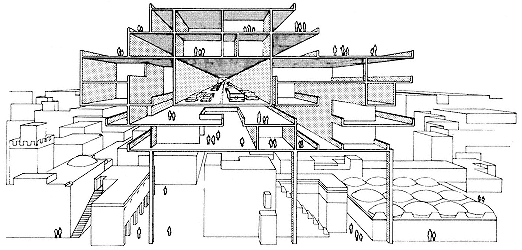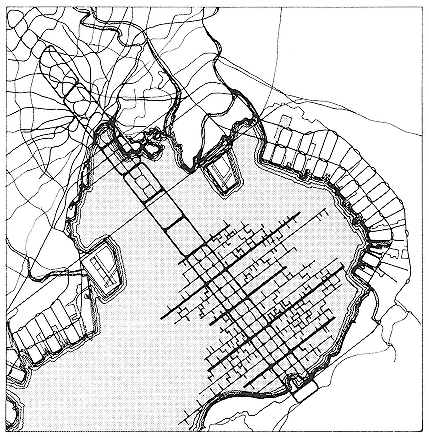The Systemic Stance
The systemic approach emphasizes large-scale elements of urban design and seeks an overall order for the urban place. Its Team 10 proponents asserted "comprehensibility" as an overriding value.[27] Systemic theory accepts urbanization and increasing societal complexity as inevitable. The key to successful urban design in a complex world is organizing the underlying systems, not individual buildings.
Although systemic theory gives priority to large-scale urban ordering, exactly what is ordered can vary. For some urban design theorists, achieving diagrammatic clarity in transportation systems is the principal task: "Today our most obvious failure is the lack of comprehensibility and identity in big cities, and the answer is surely in a clear, large scale road system—the 'Urban Motorway' lifted from an ameliorative function to a unifying function."[28] Flow and movement are the source of architecture; expressways order the city. For other designers, particularly certain Dutch architects, urban structure results from a physical armature ("support") to which "detachable units" are added: "An area can be differentiated over which the individual has control and another over which the community collectively decides."[29] Recognizing that both transportation and shelter
must be accommodated, some systemic urban design solutions integrate the two systems. The city, for them, is an interlocked system of movement corridors and structural armatures supporting housing and other uses.
From a practical point of view, overall urban ordering is necessary because of the demands of vehicular traffic, the dependency of modern life on communications, and the need for the rapid, continuous production of building elements. Efficiency in communications is achieved, in part, by separating modes of transportation; the possibility of conflict is reduced when, for example, high-speed and low-speed movement are separated and when pedestrians are removed from vehicular systems. But the rapid growth of cities and the deterioration of aging buildings also necessitate efficiency. The assembly-line production of building elements seems necessary to satisfy burgeoning demands for both new and replacement shelter. As a consequence, elements of such urban systems favor an industrial aesthetic. Systems designers advise developing "an aesthetic appropriate to mechanized building techniques and scales of operation" because such a correlation of form and manufacture is rational. Further, they find much mass housing to be culturally obsolescent and prefer "a genuinely twentieth-century technological image of the dwelling—comfortable, safe and not feudal."[30]
One innovation of systemic thinking is the notion that areas do not have to be cleared for rejuvenation to take place. Functionalist theory presupposes a clean slate, but systemic theory proposes that linear systems (of movement, of new construction) be woven into and around existing structures. Instead of conceiving of the urban fabric as a collection of building masses, systemic design treats it as a dynamic web of connections. Systems are conceived as able to grow and change incidentally without compromising the underlying order. Change of this sort is assumed to be a feature of modern life. The contrast between simple, abstract, orderly patterns and complex existing patterns is marked, as schemes by Yona Friedman and Kenzo Tange demonstrate—one hovering above a traditional city, the other harbored adjacent to it.

11.
The ideogram for the systemic orientation emphasizes the dimensionless underlying order,
which remains despite additions and subtractions.
Based on a design for Caen-Herouville by Shadrach Woods, published
in Urbanism Is Everybody's Business (Stuttgart: Karl Krämer, 1968).

12.
A new urban structure imposed upon an older fabric.
Based on a drawing by Yona Friedman in L'Architecture Mobile
(Tournai, Belgium: Casterman, 1970.)

13.
Kenzo Tange's Tokyo Bay Project.
After a drawing published in Japan Architect (April 1961).
Tange proposed a highly structured extension of Tokyo into Tokyo Bay.
Whereas we use the term systemic to refer to this stance in urban design theory, others sometimes use the term structuralist . This difference in terminology is a potential source of confusion when, for example, Kenzo Tange uses the term structuring in discussing the systems concept. He calls for "networks of communication" imitating a living body and the ability of the structure to grow and change.[31] Identifying this stance in urban design theory as structuralist may cause confusion because Claude Lévi-Strauss and others use the term to refer to anthropological concepts. Although Tange's structure and the anthropologists' and others' structuralism have some common concerns, they are fundamentally different ideas. Systemic structure imposes an order upon the world; structuralist structure finds inherent order, finds similarities between social patterns in African villages and industrial slums, for example.
Anthropological structuralism, although it can inform systemic design and planning, falters as a guide. Lévi-Strauss himself pointed out that to search for underlying order is not the same as imposing order on phenomena.[32] In effect, structuralist anthropologists have the luxury of analyzing what exists and stopping, whereas systems-oriented urban designers must analyze and then build. For example, Alison and Peter Smithson's studies of association and identity in neighborhoods led to the development of "systems of linked building complexes, which were intended to correspond more closely to the network of social relationships, as they now exist [in cities], than the existing patterns of finite spaces and self-contained buildings."[33] The anthropological concept of structure is relevant to our discussion. But instead of associating it with one theoretical orientation, like systemic theory, we find aspects of it in several of the approaches to urban design. Systemic, humanist, and even formalist theories in one way or another each reflect certain structuralist premises and concerns.
In architecture, structuralism in the anthropological sense is most often associated with Dutch architects like Herman Hertzberger and Aldo van Eyck and with a particular concern to make places that are meaningful. In that context more often than not it refers to building design rather than urban design. When Dutch structuralists design at the larger urban scale, their structuralism resembles Tange's structuring (what we call systemic thinking) and is related less to human behavior, than to the goal of having structures that can be modified to suit changing circumstances. Team 10 architects whom we identify with the humanist stance sometimes evidence structuralist values.
Because town building must respond to the scale of movement systems,[34] and systemic design tends to be abstract, designs for specific details are often absent. It is not that the human scale is of no concern but that design at the small scale apparently is left to others or to another stage of the design process. The unit of order, instead of being buildings as it has been traditionally, is now the connective system.
The extensive character of systemic urban design means that decision making must be centralized and guided by trained planners and architects. Typically they begin by seeking (or imposing) an underlying structure of movement. Other decisions follow. The design of smaller parts
may be undertaken by others, even by groups of citizens and by individuals, for some advocates of the systemic approach assume that such participation at the smaller scale of design "humanizes" the system. Others, however, assume that because the design of the parts linked by the system must be technologically sophisticated, it requires trained designers.
Most proponents of systemic urban design accept obsolescence as a fact of modern industrial civilization. Although they believe that the underlying urban system remains intact, they assume that its elements are added to or replaced in a continuing program of improvement: "To understand and use the possibilities offered by a 'throwaway' technology, [we must] create a new sort of environment with different cycles of change for different functions."[35] Improvements include both the substitution of workable for worn-out parts and the incorporation of new elements to meet the changing needs of inhabitants.
Modern transportation and modern industrial production, in particular, have made large parts of the city of the past obsolete. Because future needs and circumstances will also differ from those of both the past and the present, the very parts that constitute the city must be disposable. Nonetheless, even with the changes necessary to counter obsolescence, the urban framework will remain as the structure, the system within which changes occur.
Because it conceives of the city as a web or network that does not depend upon a center, systemic theory has little to say about the urban core. In the case of multi-nucleated urban settings, the historical center might have a specialized role as a repository and center of culture and the arts. Or it might be the focus of finance. But conceptually it would be only one of several foci of activity.
According to its critics, systemic design ignores the validity and workability of established physical and social fabrics: systemic solutions do not necessarily improve on the past; they uproot existing patterns and introduce alien ones.
Moreover, even though the clarity of systemic approaches improves the legibility of the urban fabric and the efficiency of its operation, smaller-scale, "messy," life-enhancing considerations are left to chance. Many designers favoring systemic approaches acknowledge the importance of small-scale "grain" but do not always specify how the development of an appropriate life-enhancing grain can be assured.
Finally, critics point out that although the vast systems with changeable components must of necessity be produced with modern industrial technologies, the concomitant industrial aesthetic is alien to many people.